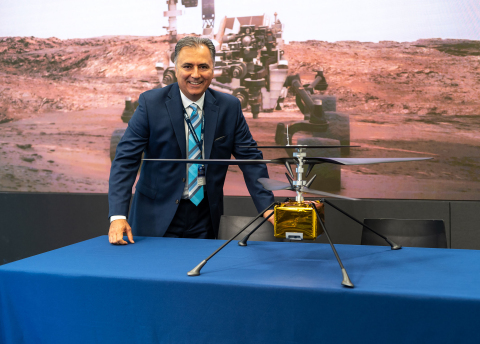AeroVironment Collaborating with NASA’s Jet Propulsion Laboratory to Build First Drone - the Mars Helicopter - to Fly on Mars
- New space endeavor draws on company’s unique and diverse history of innovation and high-altitude drone flight experience
- Drone prototypes have passed rigorous tests in simulated Mars atmosphere
- Final Mars-bound helicopter now in production at JPL
This press release features multimedia. View the full release here: https://www.businesswire.com/news/home/20180703005250/en/

AeroVironment Collaborating with
It takes on another world.
At a briefing held Wednesday at New York City’s NASDAQ Marketsite,
“AeroVironment’s deep, rich and diverse history of innovation combined
with our experience with near-space aircraft like Pathfinder and Helios
make us uniquely suited to collaborate with
Flying at nearly 100,000 feet on Earth is much like flying on the surface of Mars – same air density – so AeroVironment used airfoil design principles and simulation tools the technology company learned from record high-altitude flights and incorporated them into the Mars helicopter design.
“The Mars Helicopter effort also benefits from the ultra-lightweight and ultra-high-precision methods integral to our nano projects that have been developed in our MacCready Works laboratory, where we’ve assembled a dedicated team of the industry’s brightest and most experienced thinkers to solve some of today’s greatest technological challenges,” Nawabi said.
One of the development models was used for flight demonstration in JPL’s large 25-foot space simulator, and the other for environmental testing, including thermal tests to ensure the vehicle can endure the frigid Mars nights, and vibration tests to make sure it is rugged enough to survive launch. Both vehicles passed the rigorous tests, paving the way for the development and fabrication of the final, Mars-bound version.
The Mars Helicopter project is led by NASA JPL with team members across
JPL,
The press briefing featured high-impact visuals and models of many of
AeroVironment’s innovations, including the Snipe™
nano drone – the latest tactical UAS innovation from
ABOUT AEROVIRONMENT, INC.
FORWARD-LOOKING STATEMENTS
This press release contains “forward-looking statements” as that term is
defined in the Private Securities Litigation Reform Act of 1995.
Forward-looking statements include, without limitation, any statement
that may predict, forecast, indicate or imply future results,
performance or achievements, and may contain words such as “believe,”
“anticipate,” “expect,” “estimate,” “intend,” “project,” “plan,” or
words or phrases with similar meaning. Forward-looking statements are
based on current expectations, forecasts and assumptions that involve
risks and uncertainties, including, but not limited to, economic,
competitive, governmental and technological factors outside of our
control, that may cause our business, strategy or actual results to
differ materially from the forward-looking statements. Factors that
could cause actual results to differ materially from the forward-looking
statements include, but are not limited to, reliance on sales to the
U.S. government; availability of U.S. government funding for defense
procurement and R&D programs; changes in the timing and/or amount of
government spending; risks related to our international business,
including compliance with export control laws; potential need for
changes in our long-term strategy in response to future developments;
unexpected technical and marketing difficulties inherent in major
research and product development efforts; the impact of potential
security and cyber threats; changes in the supply and/or demand and/or
prices for our products and services; the activities of competitors and
increased competition; failure of the markets in which we operate to
grow; uncertainty in the customer adoption rate of commercial use
unmanned aircraft systems; failure to remain a market innovator and
create new market opportunities; changes in significant operating
expenses, including components and raw materials; failure to develop new
products; the extensive regulatory requirements governing our contracts
with the U.S. government; product liability, infringement and other
claims; changes in the regulatory environment; and general economic and
business conditions in
For additional media and information, please follow us at:
Twitter:
http://www.twitter.com/aerovironment
LinkedIn:
https://www.linkedin.com/company/aerovironment
Instagram:https://www.instagram.com/aerovironmentinc/
View source version on businesswire.com: https://www.businesswire.com/news/home/20180703005250/en/
Source:
AeroVironment, Inc.
Steven Gitlin, +1 626-357-9983
pr@avinc.com
